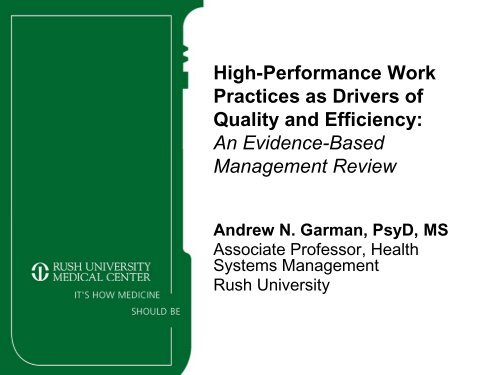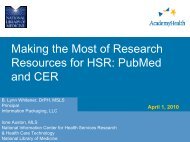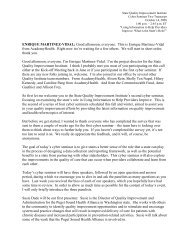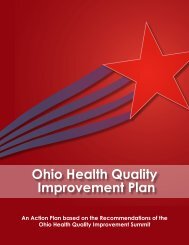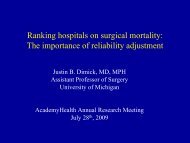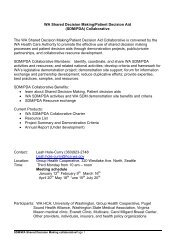High-Performance Work Practices
High-Performance Work Practices
High-Performance Work Practices
- No tags were found...
You also want an ePaper? Increase the reach of your titles
YUMPU automatically turns print PDFs into web optimized ePapers that Google loves.
<strong>High</strong>-<strong>Performance</strong> <strong>Work</strong><strong>Practices</strong> as Drivers ofQuality and Efficiency:An Evidence-BasedManagement ReviewAndrew N. Garman, PsyD, MSAssociate Professor, HealthSystems ManagementRush University
Acknowledgments• Sponsored by the Agency for Healthcare Researchand Quality (AHRQ), through the ACTION Networkinitiative– Health Research and Educational Trust• The Ohio State University• Rush University• Project team:– Ann Scheck McAlearney - The Ohio State University– Andrew N. Garman – Rush University– Megan McHugh – Health Research & Educational Trust– Paula H. Song - The Ohio State University– Michael I. Harrison – Agency for Healthcare Researchand Quality– Dina Moss – Agency for Healthcare Research andQuality
Introduction• <strong>High</strong>-<strong>Performance</strong> <strong>Work</strong> <strong>Practices</strong>(HPWPs)– Personnel practices associated withimproved organizational performance– Mutually reinforcing HR systems (or‘bundles’) are likely to have greater impact
Introduction• Considerable body of ‘more is better’research from other industries• Much less research available on whichpractices work best, in which types oforganizations, and under what conditions
Our Study• A systematic review, to identify the results withthe greatest relevance to healthcare organizations• Research questions:– What evidence is there that HPWPs can benefithealthcare organizations?– Which HPWPs / bundles appear to have the greatestpotential for benefit?– What are the mechanisms through which HPWPs havepositive effects?
Method: Literature ScanSources• Research journals– U.S., Europe, Australia– Other developed countries• Industry/trade associations– SHRM Foundation – research archives– University Healthsystems Consortium– Advisory Board• Government publications– VA system, NHS, Other (e.g., military leadership)
Results: Logic ModelExogenous FactorsFactors influencing HPWP adoption:•Senior leadership support' •Lower union density•<strong>High</strong>er number of network affiliationsFactors influencing HPWP impact & sustainability• <strong>High</strong>er quality of the local labor market• Continued leadership supportFrontlinecontrol & freedom to challengeEmployment securityReduced status distinctionsTeams / decentralizeddecision-makingLeadershipalignment & developmentManagement traininglinked to organizational needs<strong>Performance</strong> contingentcomp: ManagerSuccession planningQuality ofcandidate Pools- Pool size- Applicant qualityQuality of hires(capabilities)-Experience-Capacity to learn-Motivation-LoyaltySystem reliability /resilienceStaff resources- Staffing adequacy- Staffing stabilityStaff effectiveness- Quality focus- Communication- Problem-solvingCapacity forcontinuous systemimprovement- Motivation to learn- Capacity to learn- Freedom to'challenge the system'LaborcostsOrganizationalperformance• Fewer"never events"• Lowermalpractice costs• Innovation• Lower agencyutilization costs• Lower turnovercostsRigorousrecruitingSelectivehiringCareerdevelopmentStaff acquisition & developmentExtensiveTrainingInformationsharing(organizational)<strong>Performance</strong>contingentcomp: EmployeeOrganizational engagementConveyingmission & visionEmployeeinvolvement indecision-makingEmployee Outcomes• Lower turnover•<strong>High</strong>er satisfaction/ engagement•Lower burnout•<strong>High</strong>er generalwell-being
中 小 企 業 選 擇 育 成 中 心 之 關 鍵 因 素 及 未 來 推 動 策 略 之 研 究pp. 21-445. 信 效 度 分 析 : 信 度 係 指 根 據 測 驗 工 具 所 得 到 的 結 果 之 一 致 性 或 穩 定 性 。 目前 社 會 科 學 研 究 最 常 用 的 信 度 測 量 方 法 是 為 Cronbach α 係 數 , 此 方 法 是Cronbach 在 1951 年 提 出 , 它 克 服 部 份 折 半 法 的 缺 點 , 完 全 視 各 測 驗 題 目間 之 一 致 性 來 決 定 信 度 係 數 之 高 低 。 它 是 量 測 一 組 同 義 或 平 行 測 驗 「 總和 」 的 信 度 ( 陳 順 宇 ,1998)。 它 是 利 用 各 問 項 變 異 數 之 和 與 整 份 測 驗 分數 變 異 數 的 比 值 , 可 用 來 估 計 這 些 問 項 提 供 其 分 數 變 異 數 所 佔 的 比 例 , 其∑2k ⎡ S ⎤i公 式 為 : α = ⎢1− ⎥ , 其 中2Si 表 示 第 i 個 問 項 的 變 異 數 , ∑ Sk −1 ⎢⎣∑2S ⎥⎦表 示 所 有 問 項 和 的 變 異 數 ( 即 整 份 測 驗 分 數 的 變 異 數 ),k 是 問 項 個 數 。五 、 研 究 假 設根 據 研 究 架 構 所 提 出 之 研 究 假 設 列 示 如 下 :假 設 1: 受 訪 者 之 不 同 個 人 屬 性 ( 包 括 工 作 職 銜 、 公 司 成 立 年 數 、 產 業 別 、 公 司人 數 、 公 司 資 本 額 、 主 要 資 金 來 源 、 主 力 產 品 發 展 階 段 、 目 前 主 力 產 品所 屬 生 命 週 期 ) 與 選 擇 育 成 中 心 的 關 鍵 要 素 各 變 項 , 具 有 顯 著 差 異 。假 設 1-1: 不 同 工 作 職 銜 與 選 擇 育 成 中 心 的 關 鍵 要 素 具 有 顯 著 差 異 。假 設 1-2: 不 同 公 司 成 立 年 數 與 選 擇 育 成 中 心 的 關 鍵 要 素 具 有 顯 著 差 異 。假 設 1-3: 不 同 公 司 產 業 別 與 選 擇 育 成 中 心 的 關 鍵 要 素 具 有 顯 著 差 異 。假 設 1-4: 不 同 公 司 人 數 與 選 擇 育 成 中 心 的 關 鍵 要 素 具 有 顯 著 差 異 。假 設 1-5: 不 同 公 司 資 本 額 與 選 擇 育 成 中 心 的 關 鍵 要 素 具 有 顯 著 差 異 。假 設 1-6: 不 同 公 司 主 要 資 金 來 源 與 選 擇 育 成 中 心 的 關 鍵 要 素 具 有 顯 著 差 異 。假 設 1-7: 不 同 公 司 主 力 產 品 發 展 階 段 與 選 擇 育 成 中 心 關 鍵 要 素 具 有 顯 著 差 異 。假 設 1-8: 不 同 公 司 目 前 主 力 產 品 所 屬 的 生 命 週 期 與 選 擇 育 成 中 心 關 鍵 要 素 具 有顯 著 差 異 。29
Exogenous Factors Affecting HPWPsThe ‘enabling’ bundle: Organizational EngagementBundle #2: 'FrontlineFactors influencing HPWP adoption:control & freedom to challenge'•Senior leadership support' •Lower union densityEmployment SecurityFactors influencing • Organizational HPWP functioning & information sharingcontinued success:Reduced status distinctions• <strong>High</strong>er quality of the local labor market• Continued leadership supportQuality ofCandidate Pools- Pool size- Applicant qualityQuality of Hires(capabilities)- Experience- Capacity to learn-Motivation-LoyaltySystem reliability /capacity for selfcorrectionStaff resources- staffing adequacy- staffing stabilityStaff effectiveness- quality focus- communication- problem-solvingCapacity forcontinuous systemimprovement- Motivation to learn- Capacity to learn- Freedom to'challenge the system'Bundle #4: ‘Managementefficiency'Management traininglinked to organizational needs<strong>Performance</strong> contingentcomp: managerTeams / decentralized• Conveying mission & visiondecision-making• Employee involvement in decision-making• <strong>Performance</strong>-contingent compensationSuccession planningLaborcostsOrganizational<strong>Performance</strong>• Decreased"never events"• Decreasedmalpractice costs• More efficientInnovation adoption• Lower agencyutilization costs• Lower turnovercostsRigorousrecruitingSelectivehiringCareerDevelopmentExtensiveTrainingBundle #1: ‘Staff talent acquisition & development’Employee Outcomes-Lower voluntary &involuntary turnover-<strong>High</strong>er satisfaction/ engagement- Lower burnout-<strong>High</strong>er generalwell-being
Exogenous Factors Affecting HPWPsThe ‘high leverage’ bundle: Bundle Staff #2: 'Frontline Acquisition &control & freedom to challenge'DevelopmentEmployment SecurityFactors influencing HPWP adoption:•Senior leadership support' •Lower union densityFactors influencing HPWP functioning &continued success:• <strong>High</strong>er quality of the local labor market• Continued leadership supportQuality ofCandidate Pools- Pool size- Applicant qualityQuality of Hires(capabilities)- Experience- Capacity to learn-Motivation-LoyaltyStaff effectiveness- quality focus- communication- problem-solvingCapacity forcontinuous systemimprovement- Motivation to learn- Capacity to learn- Freedom to'challenge the system'Bundle #4: ‘Managementefficiency'Management traininglinked to organizational needsReduced status distinctions• Rigorous recruitingTeams / decentralizeddecision-making• Selective hiring• Extensive training• Career development / internal labor pools<strong>Performance</strong> contingentcomp: managerSuccession planningLaborcostsOrganizational<strong>Performance</strong>• Decreased"never events"• Decreasedmalpractice costs• More efficientInnovation adoption• Lower agencyutilization costs• Lower turnovercostsInformationsharing(organizational)System reliability /capacity for selfcorrectionStaff resources- staffing adequacy- staffing stability<strong>Performance</strong>contingentcomp: EmployeeBundle #3: ‘Organizational Engagement’CommunicatingMission & VisionEmployeeInvolvement inDecision-makingEmployee Outcomes-Lower voluntary &involuntary turnover-<strong>High</strong>er satisfaction/ engagement- Lower burnout-<strong>High</strong>er generalwell-being
Exogenous Factors Affecting HPWPsThe ‘direct effect’bundle: FrontlineFactors influencing HPWP functioning &control & freedom tocontinued success:• <strong>High</strong>er quality of the local labor market• Continued leadership supportchallengeFactors influencing HPWP adoption:•Senior leadership support•Lower union density' •<strong>High</strong>er number of network affiliationsBundle #4: ‘Managementefficiency'Management traininglinked to organizational needsSuccession planningSystem reliability /• Employment security capacity for selfcorrectionCapacity forQuality of Hirescontinuous systemStaff resources(capabilities)improvement• Reduced- staffing adequacy- Experience status distinctions - Motivation to learn- staffing stability- Capacity to learn- Capacity to learn-Motivation- Freedom to• Teams /-Loyaltydecentralized decision-making'challenge the system'Quality ofCandidate Pools- Pool size- Applicant qualityStaff effectiveness- quality focus- communication- problem-solvingLaborcostsOrganizational<strong>Performance</strong>• Decreased"never events"• Decreasedmalpractice costs• More efficientInnovation adoption• Lower agencyutilization costs• Lower turnovercostsRigorousrecruitingSelectivehiringCareerDevelopmentExtensiveTrainingBundle #1: ‘Staff talent acquisition & development’Informationsharing(organizational)<strong>Performance</strong>contingentcomp: EmployeeBundle #3: ‘Organizational Engagement’CommunicatingMission & VisionEmployeeInvolvement inDecision-makingEmployee Outcomes-Lower voluntary &involuntary turnover-<strong>High</strong>er satisfaction/ engagement- Lower burnout-<strong>High</strong>er generalwell-being
Significance / Relevance• Identifies evidence-based strategies fromother industries• Provides a holistic model for examiningpersonnel practices within healthcaresettings• Identifies salient exogenous andorganizational factors affecting HPWPoutcomes


